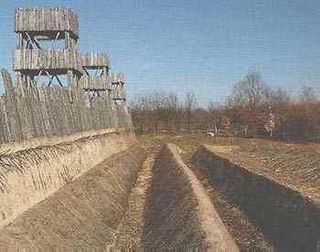Related Research Articles

A battle is an occurrence of combat in warfare between opposing military units of any number or size. A war usually consists of multiple battles. In general, a battle is a military engagement that is well defined in duration, area, and force commitment. An engagement with only limited commitment between the forces and without decisive results is sometimes called a skirmish.

A siege is a military blockade of a city, or fortress, with the intent of conquering by attrition, or a well-prepared assault. This derives from Latin: sedere, lit. 'to sit'. Siege warfare is a form of constant, low-intensity conflict characterized by one party holding a strong, static, defensive position. Consequently, an opportunity for negotiation between combatants is not uncommon, as proximity and fluctuating advantage can encourage diplomacy. The art of conducting and resisting sieges is called siege warfare, siegecraft, or poliorcetics.
Military strategy is a set of ideas implemented by military organizations to pursue desired strategic goals. Derived from the Greek word strategos, the term strategy, when it appeared in use during the 18th century, was seen in its narrow sense as the "art of the general", or "'the art of arrangement" of troops. Military strategy deals with the planning and conduct of campaigns, the movement and disposition of forces, and the deception of the enemy.

The pincer movement, or double envelopment, is a military maneuver in which forces simultaneously attack both flanks (sides) of an enemy formation. This classic maneuver holds an important foothold throughout the history of warfare.
A pocket refers to combat forces that have been isolated by opposing forces from their logistical base and other friendly forces. In mobile warfare, such as blitzkrieg, salients were more likely to be cut off into pockets, which became the focus of battles of annihilation.

Encirclement is a military term for the situation when a force or target is isolated and surrounded by enemy forces.
A military campaign is large-scale long-duration significant military strategy plans incorporating a series of interrelated military operations or battles forming a distinct part of a larger conflict often called a war. The term derives from the plain of Campania, a place of annual wartime operations by the armies of the Roman Republic.
Principles of war are rules and guidelines that represent truths in the practice of war and military operations.
Annihilation is a military strategy in which an attacking army seeks to entirely destroy the military capacity of the opposing army. This strategy can be executed in a single planned pivotal battle, called a "battle of annihilation." A successful battle of annihilation is accomplished through the use of tactical surprise, application of overwhelming force at a key point, or other tactics performed immediately before or during the battle.

A breakout is a military operation to end a situation of investment by offensive operations that achieve a breakthrough. It is used in contexts such as this: "The British breakout attempt from Normandy". It is one of four possible outcomes of investment, the others being relief, surrender, or reduction.
Deep operation, also known as Soviet Deep Battle, was a military theory developed by the Soviet Union for its armed forces during the 1920s and 1930s. It was a tenet that emphasized destroying, suppressing or disorganizing enemy forces not only at the line of contact, but throughout the depth of the battlefield.
Order No. 270, issued on 16 August 1941, by Joseph Stalin during the Axis invasion of the Soviet Union, ordered Red Army personnel to "fight to the last," virtually banned commanders from surrendering, and set out severe penalties for senior officers and deserters regarded as derelicting their duties. Order 270 is widely regarded as the basis of subsequent, often controversial Soviet policies regarding prisoners of war.
The strategy of the Roman military contains its grand strategy, operational strategy and, on a small scale, its military tactics. If a fourth rung of "engagement" is added, then the whole can be seen as a ladder, with each level from the foot upwards representing a decreasing concentration on military engagement. Whereas the purest form of tactics or engagement are those free of political imperative, the purest form of political policy does not involve military engagement. Strategy as a whole is the connection between political policy and the use of force to achieve it.
A decisive victory is a military victory in battle that definitively resolves the objective being fought over, ending one stage of the conflict and beginning another stage. Until a decisive victory is achieved, conflict over the competing objectives will continue. Like all concepts of warfare, a decisive battle can take place from the tactical or unit level, the operational level, all the way up to the strategic level or battles that bring an end to hostilities, such as the Battle of Hastings, or the Battle of Waterloo.

Investment is the military process of surrounding an enemy fort with armed forces to prevent entry or escape. It serves both to cut communications with the outside world and to prevent supplies and reinforcements from being introduced.
Envelopment is the military tactic of seizing objectives in the enemy's rear with the goal of destroying specific enemy forces and denying them the ability to withdraw. Rather than attacking an enemy head-on as in a frontal assault an envelopment seeks to exploit the enemy's flanks, attacking them from multiple directions and avoiding where their defenses are strongest. A successful envelopment lessens the number of casualties suffered by the attacker while inducing a psychological shock on the defender and improving the chances to destroy them. An envelopment will consist of one or more enveloping forces, which attacks the enemy's flank(s), and a fixing force, which attacks the enemy's front and "fixes" them in place so that they cannot withdraw or shift their focus on the enveloping forces. While a successful tactic, there are risks involved with performing an envelopment. The enveloping force can become overextended and cut off from friendly forces by an enemy counterattack, or the enemy can counterattack against the fixing force.
In military tactics, a flanking maneuver, or flanking manoeuvre, is an attack on the sides of an opposing force. If a flanking maneuver succeeds, the opposing force would be surrounded from two or more directions, which significantly reduces the maneuverability of the outflanked force and its ability to defend itself.
Relief, as a military term, refers to the breaking of a siege or an encirclement by an outside force. It may occur in conjunction with a breakout and is one of four possible conclusions of investment, the others being a breakout, surrender or reduction. The force that effects relief is known as the "relieving force" or colloquially "rescue party". Following relief, the town or fortification is said to have been "relieved".